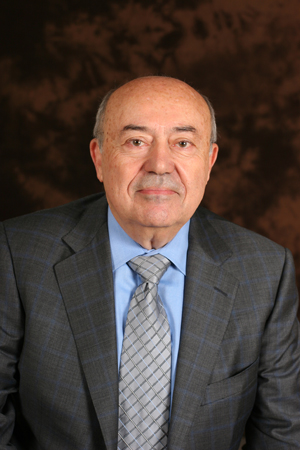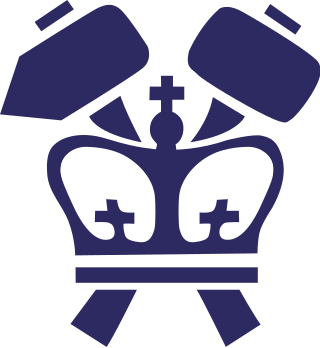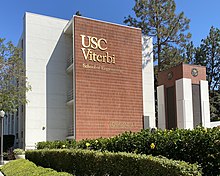
The USC Information Sciences Institute (ISI) is a component of the University of Southern California (USC) Viterbi School of Engineering, and specializes in research and development in information processing, computing, and communications technologies. It is located in Marina del Rey, California.

Andrew James Viterbi is an Italian Jewish–American electrical engineer and businessman who co-founded Qualcomm Inc. and invented the Viterbi algorithm. He is the Presidential Chair Professor of Electrical Engineering at the University of Southern California's Viterbi School of Engineering, which was named in his honor in 2004 in recognition of his $52 million gift.

The New York University Tandon School of Engineering is the engineering and applied sciences school of New York University. Tandon is the second oldest private engineering and technology school in the United States.

The Fu Foundation School of Engineering and Applied Science is the engineering and applied science school of Columbia University. It was founded as the School of Mines in 1863 and then the School of Mines, Engineering and Chemistry before becoming the School of Engineering and Applied Science. On October 1, 1997, the school was renamed in honor of Chinese businessman Z.Y. Fu, who had donated $26 million to the school.
The UC Davis College of Engineering is one of four undergraduate colleges on the campus of the University of California, Davis. One of the largest engineering programs in the U.S., the UC Davis College of Engineering offers 11 ABET-accredited undergraduate engineering majors. The college offers majors from a broad scope of engineering disciplines, including aerospace science, biochemical, biological systems, biomedical, chemical, civil, computer science, electrical, materials science, and mechanical engineering.
The School of Engineering and Applied Science (SEAS) at the George Washington University in Washington, D.C. is a technical school which specializes in engineering, technology, communications, and transportation. The school is located on the main campus of the George Washington University and offers both undergraduate and graduate programs.

The A. James Clark School of Engineering is the engineering college of the University of Maryland, College Park. The school consists of fourteen buildings on the College Park campus that cover over 750,000 sq ft (70,000 m2). The school is near Washington, D.C. and Baltimore, as well as several technology-driven institutions.
Alampallam Venkatachalaiyer Balakrishnan (1922-2015) was an American applied mathematician and professor at the University of California, Los Angeles.
The academics of the University of Southern California center on The College of Letters, Arts, and Sciences, the Graduate School, and its 17 professional schools.

Yannis C. Yortsos is a Greek-American chemical engineer and academic, currently serving as Dean of the Viterbi School of Engineering at the University of Southern California.

The John and Marcia Price College of Engineering at the University of Utah is an academic college of the University of Utah in Salt Lake City, Utah. The college offers undergraduate and graduate degrees in engineering and computer science.

The Brown University School of Engineering is the engineering school of Brown University, a private Ivy League research university located in Providence, Rhode Island. Brown's engineering program is the third oldest civilian engineering program in the United States and the oldest undergraduate program in the Ivy League. The School of Engineering is noted for its historically prominent contributions to continuum and applied mechanics, originally led by European émigré researchers in the 20th century. Brown's Division of Engineering was elevated in 2010 to its current status as a school.
The University of Missouri College of Engineering is one of the 19 academic schools and colleges of the University of Missouri, a public land-grant research university in Columbia, Missouri. The college, also known as Mizzou Engineering, has an enrollment of 3,204 students who are enrolled in 10 bachelor’s programs, nine master’s programs and seven doctorate programs. There are six academic departments within the College: Chemical and Biomedica Engineering; Civil and Environmental Engineering; Electrical Engineering and Computer Science; Industrial and Systems Engineering; Engineering and Information Technology; and Mechanical and Aerospace Engineering. The college traces its beginning to the first engineering courses taught west of the Mississippi River in 1849. The college was ranked 88th nationally by the U.S. News & World Report in 2016.
Anita Sengupta is an American aerospace engineer. She is a graduate in aerospace and mechanical engineering of the Viterbi School of Engineering at the University of Southern California. She was the lead systems engineer of the team that developed the parachute system that was deployed during the landing of Mars Science Laboratory Curiosity. She was subsequently the project manager of the Cold Atom Laboratory at the Jet Propulsion Laboratory at Caltech. She was then the Senior Vice President of Systems Engineering at Virgin Hyperloop One. She is currently Chief Product Officer at Airspace Experience Technologies (ASX).
Robert E. "Rob" Meyerson is an American aerospace engineer and executive.

Mike Gruntman is a Russian-American physicist, space engineer, and author. He is professor of astronautics and aerospace engineering at the Viterbi School of Engineering, University of Southern California (USC).
The Ann and H.J. Smead Department of Aerospace Engineering Sciences is a department within the College of Engineering & Applied Science at the University of Colorado Boulder, providing aerospace education and research. Housed primarily in the Aerospace Engineering Sciences building on the university's East Campus in Boulder, it awards baccalaureate, masters, and PhD degrees, as well as certificates, graduating approximately 225 students annually. The Ann and H.J. Smead Department of Aerospace Engineering Sciences is ranked 10th in the nation in both undergraduate and graduate aerospace engineering education among public universities by US News & World Report.
Tim Ellis is an American aerospace engineer and the co-founder and CEO of Relativity Space.











